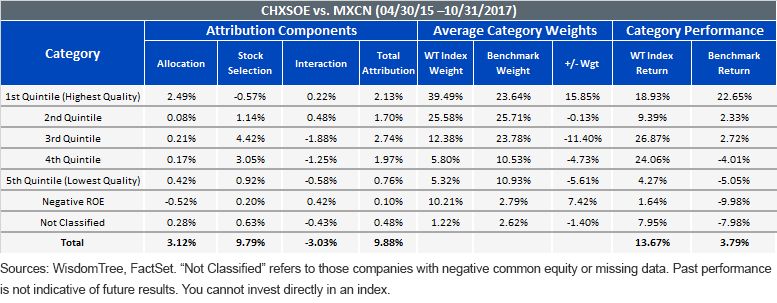A Smarter Way To Approach Chinese Equity
More than 20% government ownership in an emerging market (EM) company can create a conflict between the interests of shareholders and government stakeholders, which may, in turn, affect profitability and future returns. With this premise in mind, we developed a framework allowing us to answer this question: “What impact does meaningful government ownership have on equity returns?”
China represents a very large opportunity set for global equity investors, and its economy is the perfect example of how government ownership affects a company’s performance. With China’s importance to overall emerging markets unquestioned, we figured it made sense to use that as an initial case study in this piece.
Quantifying Government Ownership: Is It Worth Owning State-Owned Enterprises?
Considering that 2017 has been a notable year for China’s equity market, we wanted to measure the impact of state-owned enterprises (SOEs) on the return of a commonly used beta benchmark such as the MSCI China Index (MXCN). To do so, we split MXCN’s constituents into SOEs and non-SOEs, and ran the following contribution to total return analysis.
Returns: SOEs vs. Non-SOEs

Year-to-date, MSCI China Index has had roughly the same exposure to SOEs and non-SOEs, with the latter segment significantly outperforming. Said a different way, MXCN can attribute almost 80% of its total return to non-SOE exposure.
How to Capitalize on the non-SOE Opportunity
Building off these observations, in 2015 we launched a less-conventional approach to tap into the Chinese equity market, focusing on those companies that are free of significant government ownership. The WisdomTree China ex-State-Owned Enterprises Index (CHXSOE) measures the performance of Chinese stocks that are not state-owned enterprises (less than 20% government owned). To measure its success thus far, we used a similar concept mentioned above and ran a performance attribution analysis for CHXSOE versus MXCN, splitting their constituents into SOEs and non-SOEs.

Since its inception, CHXSOE has outperformed the MSCI China Index by almost 1,000 basis points (bps) annually. During this period, MXCN’s average exposure to SOEs was 58%, which means CHXSOE had an active under-weight in that category of 58%. This under-weight in SOEs and the corresponding over-weight in non-SOEs during the period explain most of CHXSOE’s excess return. The right-most column shows, once again, how MXCN exposure to SOEs has been a drag to its performance, as they’ve returned -6.37%, underperforming non-SOEs by more than 24% annually during the period.
Non-SOEs as a Proxy for Quality
While conducting this analysis, we realized that companies with less government ownership have, on average, higher return on equity (ROE). Using our newly developed factor attribution framework, we can show that favoring non-SOEs is also a way to access the quality factor. Taking ROE as a measurement for quality, we segmented the EM equity universe into five ROE quintiles, the first being the top 20% measured by ROE (representing the highest-quality segment of the market) and the fifth quintile being the bottom 20% (representing the lowest-quality segment).

Since inception, CHXSOE was on average almost 16% over-weight in the highest-quality segment of the market, amounting to 250 bps of annual outperformance. Conversely, CHXSOE was less exposed to the three lowest-quality segments of the market.
Conclusion
We believe non-SOE exposure could be a smarter way to approach Chinese equity markets. Having shareholder interests as a top priority helps companies be more profitable and could increase future expected returns.
Disclaimer: Investors should carefully consider the investment objectives, risks, charges and expenses of the Funds before investing. U.S. investors only: To obtain a prospectus containing this ...
more



Good analysis and a good conclusion. Central bank and government investment in the market is generally not good for those it invests in long term and is equally adverse to the economy as it distorts economic signalling and other things than market forces affect the sectors they are in.